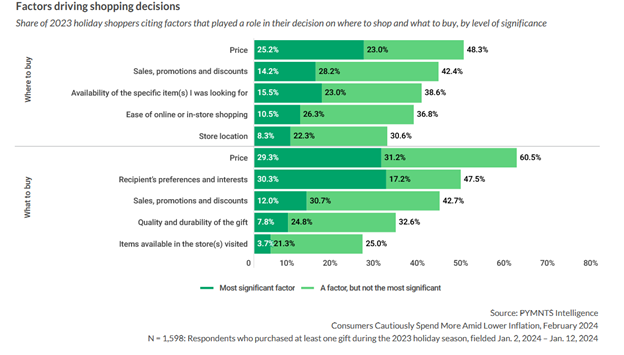Consumers Are Spending More, but 6 in 10 Check the Price Tag First

As reported last week, data from the Bureau of Economic Analysis confirms February consumer spending was up, a trend some analysts believe could influence the Fed’s decision to lower interest rates later this year.
That consumers are spending more — despite ongoing signs of creeping inflation and stalled incomes — may not come as news to those who follow PYMNTS Intelligence reports, however.
As we reported in the latest edition of “The Consumer Inflation Sentiment Report”: Consumers have been spending more on retail items, suggesting renewed confidence on their part. But as the report “The Cautious Spender: US Consumers Now Think First, Spend Second” makes clear, their shopping habits also reflect a high degree of wariness.
The report, the 19th installment in our “Consumer Inflation Sentiment” series, draws on data from nearly 5,000 U.S. consumers who were surveyed about their end-of-year 2023 spending habits as well as their plans for 2024.
The data confirmed that retail sales picked up speed in the last half of 2023, especially in the final weeks of the year, when spending jumped 6.8% over end-of-year 2022 sales. The retail segments that benefited the most from this jolt were health and pharmacy shops and sporting and hobby stores, outlays that suggest consumers were prioritizing spending on health, wellness and leisure activities.
Consumer optimism was understandable at the time, given the fact that 2023 closed with reduced inflation — 3.4% in December. Retail inflation also hovered at just 0.2% in December, marking 20 consecutive months of low retail inflation.
However, after the holiday ended, consumer outlook shifted slightly. As of January, 63% of the consumers surveyed said they were cutting back on spending due to increasing prices. This could be attributed to a holiday-shopping hangover, except that the cutback rate was actually down from 69% in January 2022. Meanwhile, 51% of shoppers told us they were frequenting new merchants specifically to save money.
In other words, consumers were spending, but in a more circumspect fashion.

As the figure above illustrates, price remains the leading factor for consumer shopping decisions. When shoppers think about what to buy, more than 60% told us that price is a factor in that choice — and 29% say price is the most significant factor. Similarly, when deciding where to shop, more than 48% say price shapes their decision, with 25% saying it is the most significant consideration.
The other considerations on the list above (ease of online shopping, store location, etc.) speak for themselves, but one category — “sales, promotions and discounts” — stands out when considering current consumer shopping habits. After all, sales, promotions and discounts all shape buying decisions. This is why, when deciding what to buy, nearly 43% of respondents say they factor in sales, promotions and discounts. When considering where to buy, 42% of consumers do the same.
The report also showed that, as of the end of 2023, 77% of respondents were comfortable buying gifts for others (and themselves), but 56% of them selected those gifts ahead of time, demonstrating further the move toward strategic spending.
Although consumers are continuing to shop, suggesting a degree of confidence in the economy, ongoing concerns about rising inflation, stagnant wages and high interest rates are never far away. About 14 months ago, 83% of consumers complained their wages were not keeping pace with inflation; 82% said the same thing when surveyed in January. This might explain why so many still look for cheaper merchants, sales and discounts. Yes, consumer spending is up slightly, but the emphasis on saving money while shopping underscores a clear sense of caution.
